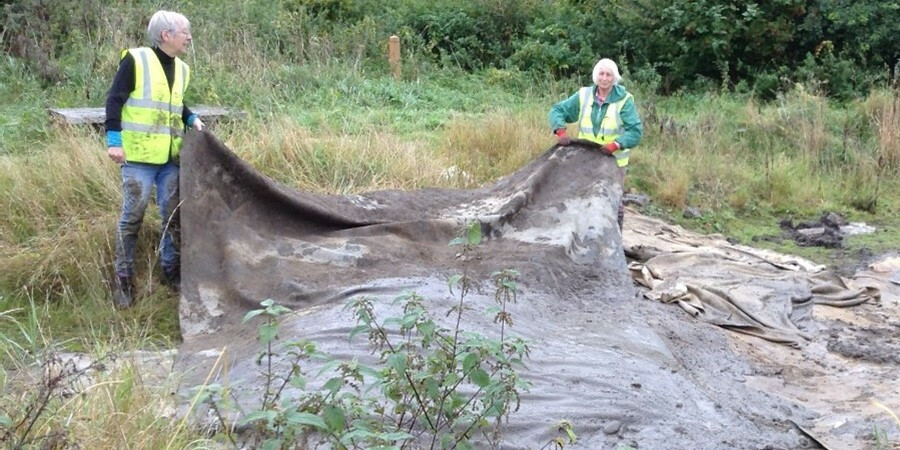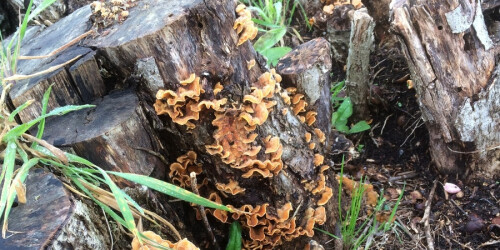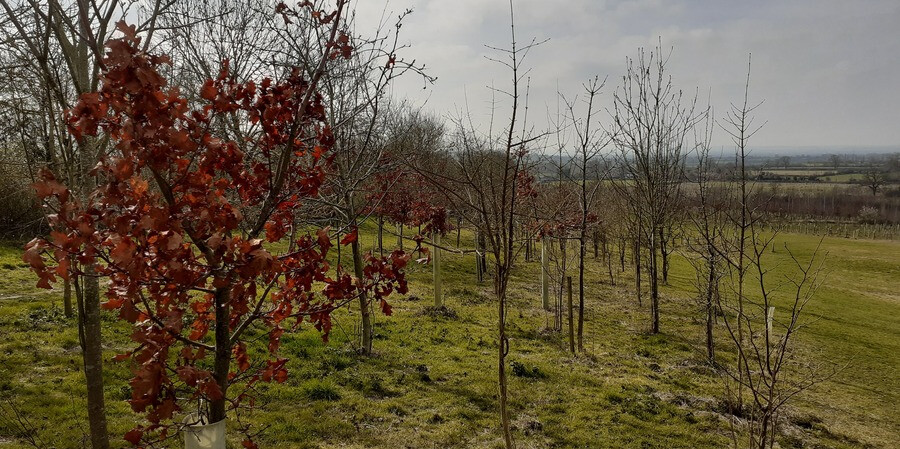Discover Diamond Jubilee Wood near Caen Hill Devizes
Combine your visit to Caen Hill Locks with a leisurely stroll through Jubilee Wood or explore one of the three circular waymarked Discovery Trails.


Pond power
The land, previously a pig farm, had four ponds which have been lost over time. Because ponds are so important for wildlife, we created a new one.
We fitted it with a liner, but this started to bubble up when water became trapped between it and the clay soil. Cracks formed and the water mostly drained away. However, where water remained aquatic insects moved in, followed by newt efts (the larvae of newts).
In winter 2021, Jubilee Wood volunteers, with guidance from Trust ecologists, removed the damaged sections of liner but left in place any undamaged liner, thus creating a series of small ponds.

Volunteers Joan and Jane remove the pond liner
Following heavy rain, we found the main pond was holding water better without the liner in place! When a pond holds water for only part of the year, it is known as a ‘temporary pond’. It makes fantastic habitat, often supporting rarer species than permanent ponds. Drying out removes fish, which eat amphibian larvae and aquatic insects, allowing these species to thrive.
Now that we have improved the pond for wildlife we are expecting to see hundreds of insect species colonise the pond, including dragonflies, damselflies, caddis flies and mayflies. These all have a larval stage that lives underwater all year and an adult flying stage, generally on the wing from April to September.

Banded demoiselle
Water beetles, slaters and ‘wigglies’ live in the water all year. With all this insect food available, we hope that amphibians such as frogs, toads and newts will move in. If we’re lucky, great crested newts will find the pond and breed here. They are a European protected species.
Please keep dogs out of the water so the wildlife is undisturbed and allow the wildlife to colonise naturally; no fish or frogspawn, thank you!
Dead brilliant
The Victorians created stumperies in their gardens as places where they could show off their ferns. They may not have realised that stumperies also provide excellent food and shelter for creatures such as stag beetles, where the larvae will spend many years living underground in the decaying wood.
The wood still contains all the nutrients that the tree absorbed when alive, and it takes specialist organisms to break these down and return them to the soil.

Fungi on the stumpery
Have you heard of the Wood Wide Web? In 1997, ecologist Suzanne Simard discovered an underground network of tree roots and fungal filaments connecting trees so they can communicate with each other and share precious resources such as carbon and phosphorous. This web benefits fungi, which take sugars from the plants in exchange for soil nutrients. Did you know that mushrooms and toadstools are the fruiting bodies of fungi, like apples on a tree?
Immortal tree
Enjoy wandering through our oak parkland, a mix of mature trees and saplings planted to commemorate the Queen’s Diamond Jubilee in 2012. Oak trees can live for more than 1000 years, although we don’t have such ancient ones here! We can estimate a tree’s age by measuring its trunk but only by counting the growth rings of a fallen tree can we be sure.

As they age their trunks widen and their crowns reduce; this is known as retrenchment. Fungi will rot out the dead heartwood in the middle of the tree, leaving them hollow, which makes them more stable.
New shoots will sprout from the trunk or branches, including those attached but touching the ground. They will continue growing after the main tree has died, forming new trees.
An oak tree can provide a home for 2000 species including more than 30 species of mammal, 70 species of bird, 34 species of butterfly and 280 species of insect. Oaks are also home to lichen, ferns and fungi which will grow on the tree and around its roots.
Local family represented in oak circle
The oak saplings in our Oak Circle were planted by a local family. Each sapling represents a family member, and they will be able to enjoy watching them grow over the years.
A little bit of royal Windsor
Our Royal Oak sapling was planted in celebration of the marathon effort to plant 30,000 trees to create this wood. It grew from an acorn taken from a very old oak tree in Windsor Great Park.
Last date edited: 31 August 2022